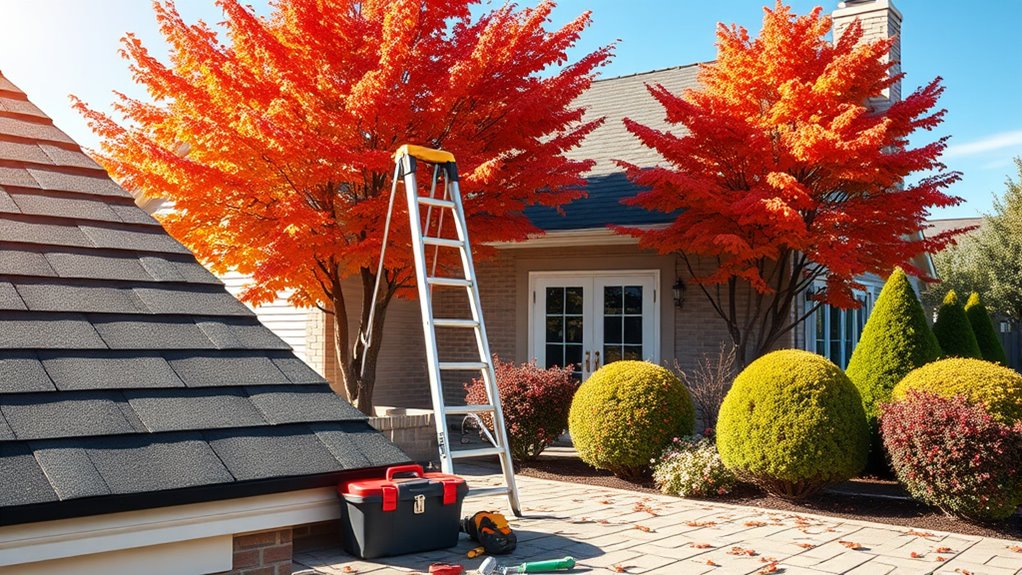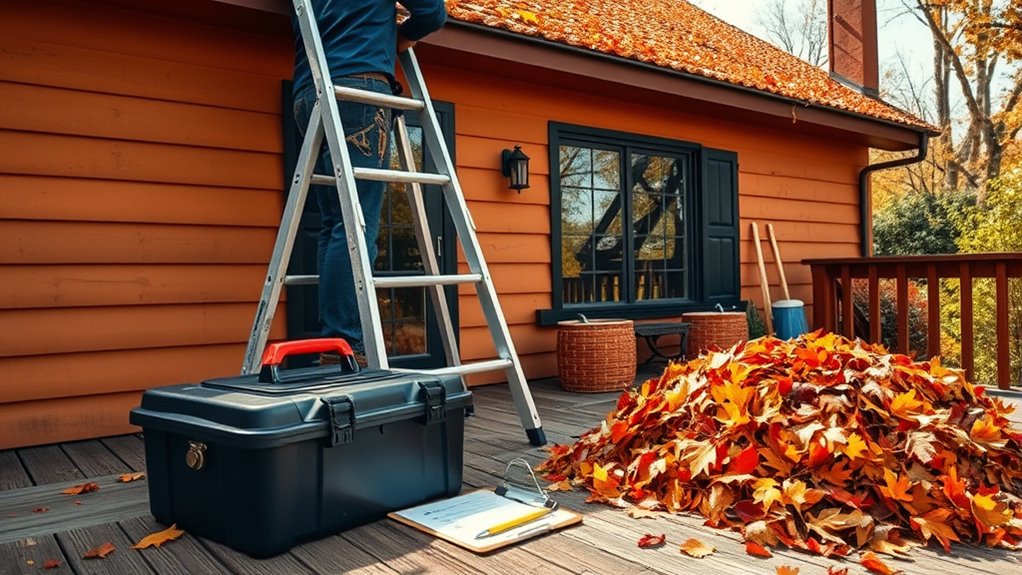To prevent costly repairs, perform seasonal home maintenance tasks like checking and cleaning gutters, changing filters in your HVAC system, and inspecting roof shingles for damage. Seal windows to boost energy efficiency and remove debris to avoid water damage. Regular upkeep of your home’s key systems and addressing minor issues early can save you money and extend your home’s lifespan. Keep exploring to find out more tips that help protect your home year-round.
Key Takeaways
- Regularly inspect and replace HVAC filters every 1-3 months to ensure efficiency and air quality.
- Clear gutters of debris, check for leaks or damage, and consider gutter guards to prevent water issues.
- Schedule annual professional HVAC inspections to identify and fix problems early, extending system lifespan.
- Seal windows and inspect roof shingles to enhance energy efficiency and prevent water infiltration.
- Maintain landscaping and ensure proper drainage to avoid water pooling, foundation damage, and basement flooding.

Have you ever wondered if your home is as well-maintained as it should be? Staying on top of seasonal home maintenance might seem overwhelming, but it’s essential to prevent costly repairs down the line. One of the first steps is to focus on HVAC system care. Your heating, ventilation, and air conditioning system works hard year-round, and neglecting it can lead to inefficiency or breakdowns when you need it most. Start by changing the filters regularly—ideally every one to three months—especially during peak seasons. Dirty filters strain the system, increase energy bills, and reduce air quality. It’s also wise to schedule a professional inspection annually to catch any potential issues before they worsen. An HVAC technician can examine your system’s components, check refrigerant levels, and clean coils, ensuring it operates smoothly and efficiently. Doing so not only prolongs the system’s lifespan but also saves you money on energy costs.
Equally important is gutter inspection. Gutters are your home’s first line of defense against water damage, and clogged or damaged gutters can cause serious problems. During seasonal changes, debris like leaves, twigs, and dirt accumulate quickly, blocking water flow. Regular gutter inspection allows you to identify blockages early and clear them out before heavy rains or snowmelt overwhelm your drainage system. Use a sturdy ladder to safely check the gutters’ condition, looking for leaks, sagging sections, or loose brackets. If you notice rust or holes, it’s time to repair or replace damaged gutters. Properly maintained gutters direct water away from your foundation, preventing leaks, cracks, and even basement flooding. To make maintenance easier, consider installing gutter guards, which reduce debris buildup and minimize cleaning frequency. Remember, neglecting gutter inspection can lead to water infiltration, mold growth, and structural deterioration—costly repairs that are easily avoided with a little regular attention. Incorporating AI technology into your home maintenance routine can help monitor and alert you to potential issues early on.
Beyond HVAC care and gutter inspection, don’t forget other seasonal tasks like sealing windows, inspecting roof shingles, and maintaining landscaping. But focusing on these core areas will give you a solid foundation for protecting your home. Taking a proactive approach means you’re less likely to face emergency repairs that disrupt your budget and daily life. Keep a checklist, schedule regular inspections, and address minor issues promptly. When you stay ahead of maintenance, you extend the life of your home’s systems and structure, saving yourself money and stress in the long run. Ultimately, consistent seasonal upkeep isn’t just about appearance—it’s about ensuring your home remains safe, efficient, and comfortable year-round.
Frequently Asked Questions
How Often Should I Inspect My Roof for Damage?
You should inspect your roof at least twice a year for damage assessment. Regular roof inspections help you catch issues early, especially after severe weather like storms or heavy snow. Look for missing shingles, cracks, or signs of wear. If you notice any damage, act quickly to prevent costly repairs. Staying proactive with routine roof inspections keeps your home safe and maintains its value over time.
What Are Signs of Hidden Water Leaks in My Home?
You might not notice it, but hidden water leaks can sneak past your awareness. Keep an eye on musty odors, unexplained stains, or peeling paint, which can hint at trouble lurking behind walls. Regular plumbing inspections and careful detection of mold growth are key. Addressing these signs early prevents water damage, costly repairs, and health risks, ensuring your home stays safe and dry without surprises.
How Can I Improve Indoor Air Quality During Seasonal Changes?
To improve indoor air quality during seasonal changes, you should use air purifiers to remove allergens and pollutants. Additionally, adding indoor plants can naturally filter toxins and boost humidity, making your environment healthier. Keep your home well-ventilated by opening windows when weather permits, and regularly clean surfaces to reduce dust. These simple steps help make certain cleaner air and a more comfortable living space during seasonal transitions.
When Should I Replace Weather Stripping Around Doors and Windows?
You should replace weather stripping around doors and windows when you notice door seal degradation or window draftiness. These signs indicate that the seal isn’t effective anymore, causing energy loss and higher bills. Regularly check for gaps, peeling, or worn-out material. Replacing weather stripping promptly ensures your home stays comfortable, energy-efficient, and prevents costly repairs caused by moisture or drafts. Don’t wait until problems worsen—act at the first signs.
What Are Eco-Friendly Options for Winter Insulation?
Think of eco-friendly winter insulation as wrapping your home in a warm, sustainable blanket. You can choose sustainable insulation options like sheep’s wool, cellulose made from recycled paper, or cork, which all provide excellent thermal protection. These eco-friendly materials not only reduce your carbon footprint but also keep your home cozy. Using sustainable insulation helps you save energy and supports a healthier planet, much like protecting your home with a natural, effective shield.
Conclusion
By staying on top of this seasonal home maintenance checklist, you’ll save yourself from potential disasters that could cost a fortune—think of it as protecting your home from turning into a money-draining nightmare. Regular upkeep keeps your house running smoothly and prevents small issues from exploding into costly repairs. Don’t wait for catastrophe to strike; act now and keep your home safe, sound, and worry-free all year round. Your future self will thank you for this smart move!









